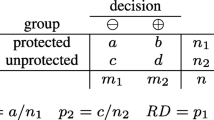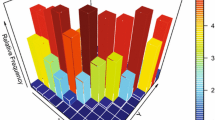Abstract
Discrimination law is a possible application of the methods of causal modelling. With it, it brings the possibility of direct statistical evidence on counterfactual questions, something that traditional techniques like multiple regression lack. The kinds of evidence that causal modelling can provide, in large part due to its attention to counterfactuals, is very close to the key question that we ask of jurors in discrimination cases. With this new kind of evidence comes new opportunities. We can better proportion punitive damages to the severity of the discrimination that manifests in a hiring process. We can avoid making certain kinds of assumptions regarding the relationship between protected classes and hiring qualifications that other statistical methods demand from statisticians. We can also distribute restitution to individual claimants in a way that is proportionate to how their application was treated in the hiring process. Here we explore where and how causal modelling can be useful in discrimination law and policy. What elements of law provide friction with this mode of gathering statistical evidence, what new possibilities does it reveal, and how does this integrate with prior judgments regarding statistical evidence?

Similar content being viewed by others
Notes
I will leave out discussion of how these values are specifically calculated. See Causal Inference in Statistics by Pearl et al. for an accessible introduction.
Gehring v. Case Corp., 43 F.3d 340 (7th Cir. 1994).
Gehring v. Case Corp., 43 F.3d 340 (7th Cir. 1994).
Adapted from an example in Tribe’s Trials by Mathematics.
Teamsters v. United States, 431 U.S. 324, 97 S. Ct. 1843, 52 L. Ed. 2d 396 (1977).
Sindell v. Abbott Laboratories, 607 P.2d 924, 26 Cal. 3d 588, 163 Cal. Rptr. 132 (1980).
Sindell v. Abbott Laboratories, 607 P.2d 924, 26 Cal. 3d 588, 163 Cal. Rptr. 132 (1980).
Modal realists will object here, but may still agree with the broader point depending on their views on probabilities across sets of possible worlds.
Amazon recently came under scrutiny for such software that discriminated against women by giving lower scores to resumes with women’s organizations on them. See Amazon scraps secret AI recruiting tool that showed bias against women by Jeffrey Dastin.
Obergefell v. Hodges, 135 S. Ct. 2071, 576 U.S. 644, 191 L. Ed. 2d 953 (2015).
Masterpiece Cakeshop v. Colo. Civil Rights, 138 S. Ct. 1719, 584 U.S., 201 L. Ed. 2d 35 (2018).
See Rao’s Three concepts of dignity in constitutional law for many more examples.
References
Bou-Habib, P. (2011). Racial profiling and background injustice. The Journal of Ethics, 15(1), 33–46.
Braun, L. J. (1980). Statistics and the law: Hypothesis testing and its application to Title VII cases. Hastings Law Journal, 32, 59.
Enoch, D., Spectre, L., & Fisher, T. (2012). Statistical evidence, sensitivity, and the legal value of knowledge. Philosophy and Public Affairs, 40(3), 197–224.
Kaye, D. (1982). The limits of the preponderance of the evidence standard: Justifiably naked statistical evidence and multiple causation. American Bar Foundation Research Journal, 7(2), 487–516.
Kaye, D., & Aickin, M. (2014). Statistical methods in discrimination litigation. CRC Press.
Keele, L., & Stevenson, R. T. (2021). Causal interaction and effect modification: Same model, different concepts. Political Science Research and Methods, 9(3), 641–649.
Malone, W. S. (1956). Ruminations on cause-in-fact. Stanford Law Review, 9(1), 60–99.
National Research Council. (2011). Reference manual on scientific evidence (3rd ed.). The National Academies Press.
Pardo, M. S. (2018). Safety vs. sensitivity: Possible worlds and the law of evidence. Legal Theory, 24(1), 50–75.
Pearl, J. (2013). Direct and indirect effects. arXiv preprint arXiv:1301.2300
Pearl, J., Madelyn, G., & Jewell, N. P. (2016). Causal inference in statistics: A primer. Wiley.
Shavell, S. (2009). Economic analysis of accident law. Harvard University Press.
Stout, N. C., & Valberg, P. A. (2004). Bayes’ law, sequential uncertainties, and evidence of causation in toxic tort cases. University of Michigan Journal of Law Reform, 38, 781.
Thomson, J. J. (1986). Liability and individualized evidence. Law and Contemporary Problems, 49, 199.
Thompson, W. C. (1989). Are juries competent to evaluate statistical evidence. Law and Contemporary Problems, 52, 9.
Thompson, W. C., & Schumann, E. L. (2017). Interpretation of statistical evidence in criminal trials: The prosecutor’s fallacy and the defense attorney’s fallacy (pp. 371–391). Routledge.
Tribe, L. H. (1970). Trial by mathematics: Precision and ritual in the legal process. Harvard Law Review, 84, 1329.
U.S. Equal Employment Opportunity Commission. (1988). CM-604 Theories of Discrimination. U.S. Equal Employment Opportunity Commission.
Wright, R. W. (1985). Causation in tort law. California Law Review, 73, 1735.
Acknowledgements
I am deeply grateful to Jim Woodward for the invaluable discussion, draft notes, and feedback he has given me. I am also thankful for Sandra Mitchell and Jonathan Fuller for their helpful comments on earlier drafts. The detailed, insightful, and substantive reviews from the anonymous referees were immensely helpful. Their feedback heavily influenced the arguments and trajectory of this paper.
Author information
Authors and Affiliations
Corresponding author
Ethics declarations
Conflict of interest
The author has no conflicts of interests to disclose.
Additional information
Publisher's Note
Springer Nature remains neutral with regard to jurisdictional claims in published maps and institutional affiliations.
Rights and permissions
Springer Nature or its licensor (e.g. a society or other partner) holds exclusive rights to this article under a publishing agreement with the author(s) or other rightsholder(s); author self-archiving of the accepted manuscript version of this article is solely governed by the terms of such publishing agreement and applicable law.
About this article
Cite this article
Shin, J. Statistical evidence, discrimination, and causation. Synthese 200, 490 (2022). https://doi.org/10.1007/s11229-022-03958-7
Received:
Accepted:
Published:
DOI: https://doi.org/10.1007/s11229-022-03958-7




